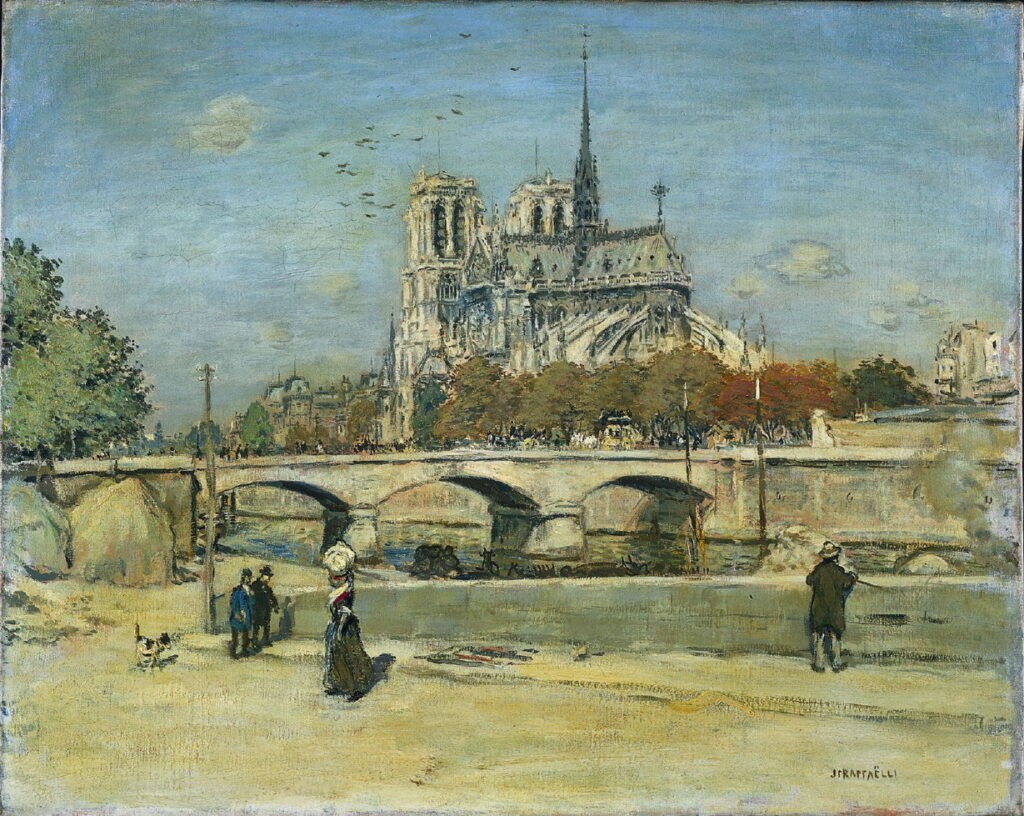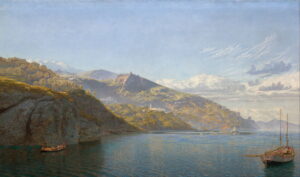A to Z of Landscapes: Quais

Although there aren’t many candidates for the letter q in this alphabet of landscape painting, there’s one that played a significant role in their development during the nineteenth century: quais, French for quays, the name given to river embankments, particularly those on the River Seine in Paris.
Richard Parkes Bonington (1802–1828), View of the Pont des Arts from the Quai du Louvre (c 1819-20) (14), watercolour over graphite on medium, cream, slightly textured wove paper, 21 x 29 cm, Yale Center for British Art, New Haven, CT. Wikimedia Commons.
One of the earliest of these views of the quais in Paris is this watercolour painted by the English artist Richard Parkes Bonington in about 1819-20 of the View of the Pont des Arts from the Quai du Louvre.
Johan Jongkind (1819–1891), View from the Quai d’Orsay (1854), oil on canvas mounted on wood, 43.8 x 66 cm, Metropolitan Museum of Art, New York, NY. Wikimedia Commons.
Johan Jongkind painted this superb View from the Quai d’Orsay in 1854. Made near what is now the Musée d’Orsay, at this time it was a working quai serving a busy part of the city. On the bank was the Palais d’Orsay, which had originally been intended to be the Ministry of Foreign Affairs when it was built in 1838, but was then being used by the Court of Accounts and the State Council. Less than twenty years later, during the Paris Commune of 1871, the whole area was burned to the ground, and later redeveloped for the railway station which in turn became the Musée d’Orsay, appropriately holding one of the finest collections of Impressionist painting in the world.
Pierre-Auguste Renoir (1841–1919), The Pont des Arts Paris (1867-68), oil on canvas, 60.9 x 100.3 cm, Norton Simon Museum, Pasadena, CA. Wikimedia Commons.
Auguste Renoir painted The Pont des Arts Paris in April 1867. This detailed realist view shows the pedestrian bridge from the left bank of the Seine. It had been the first metal bridge in Paris when it was constructed in 1802-04, and connects the Institut de France, whose dome is prominent at the right, with the Louvre, away to the left.
Stanislas Lépine (1835–1892), The Quay, Pont-Marie, Paris (1868), oil on canvas, dimensions not known, Musée d’Orsay, Paris. Wikimedia Commons.
Stanislas Lépine’s The Quay, Pont-Marie, Paris (1868) is a finely-painted but clearly non-Impressionist view of the Seine in Paris. Compare that with Guillaumin’s Pont Marie, Quai Sully (1878) just a decade later, below.
Armand Guillaumin (1841-1927), Pont Marie, Quai Sully (1878), oil on canvas, dimensions and location not known. Wikimedia Commons.
Paul Signac (1863-1935), Quai de Clichy. Temps gris (Op 156) (1887 Apr-May), oil on canvas, 46 x 65.5 cm, Private collection. Wikimedia Commons.
Paul Signac’s Quai de Clichy. Temps gris is one of a pair of views of this section of the bank of the River Seine. This shows the quai in grey weather, and was thought to have been lost for many years; its partner shows a different view in sunlight.
The Quai de la Tournelle has been a popular point for painting views of Notre-Dame. The next two paintings show similar views painted about fifty years apart.
Johan Jongkind (1819–1891), Paris, Notre-Dame Seen From Quai de la Tournelle (1852), oil on canvas, dimensions not known, Petit Palais, Paris. Image by Antoine Taveneaux, via Wikimedia Commons.
Johan Jongkind’s classic view of Paris, Notre-Dame Seen From Quai de la Tournelle was completed in 1852, before the construction of Notre-Dame’s spire, added the following decade.
Jean-François Raffaëlli (1850-1924), Notre Dame Seen from the Quai de la Tournelle (c 1897-1902), oil on fabric, 65 × 81.2 cm, Cleveland Museum of Art, Cleveland, OH. Wikimedia Commons.
Jean-François Raffaëlli still kept quite fine detail in his view of Notre Dame Seen from the Quai de la Tournelle, painted around the turn of the century in 1897-1902. The spire is now prominent, and construction work has been completed.
Maximilien Luce (1858–1941), Quai Saint-Michel and Notre-Dame (1901), oil on canvas, 73 x 60 cm, Musée d’Orsay, Paris. Wikimedia Commons.
Maximilien Luce painted several views of the cathedral of Notre-Dame and central Paris, of which his Quai Saint-Michel and Notre-Dame from 1901 is perhaps the best-known. This looks in the opposite direction, at the front of the cathedral on its north-west end.
Camille Pissarro (1830–1903), The Quai Malaquais and the Institute (1903), oil on canvas, 54.4 x 65 cm, Private collection. Wikimedia Commons.
Camille Pissarro’s view of The Quai Malaquais and the Institute of France is one of several he painted from windows over the centre of the city, and one of the last paintings he completed before his death in 1903.




